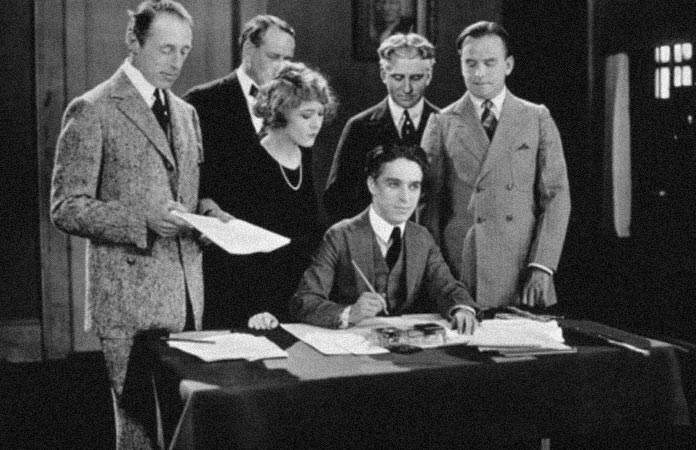Today In Pop Culture: The Birth Of United Artists
Published on February 5th, 2016 in: Movies, Today In Pop Culture, TV |Movie studios are often thought of as being owned by faceless bastards, money men, and committees. The reason for that is because it’s true. That is how most studios are. There was a time when some folks set out to change that.
On this date in 1919, the United Artists studio was created for the stars, by the stars. Director D.W. Griffith and popular performers Charlie Chaplin, Mary Pickford, and Douglas Fairbanks formed the company in an attempt to assert creative control over their own projects. At that time, what was known as the “studio system” was starting to come down and these people, rebels of their time, wanted no part of it.
The studio system was the iron fist of Hollywood. Actors were signed to long-term contracts and not allowed to work for other studios, no matter how enticing the project. The studios also owned the distribution companies, thereby exerting pressure on the exhibitors to show only films made by a certain studio. It was possible to totally squeeze a smaller film out of the picture, as it were, with the right pressure from the studios.
The original plan was for UA to produce five feature films every year. This was a huge undertaking at the time, and the larger studios were convinced that UA couldn’t do it, even after their first film was a success. UA was a privately held company, gathering operating costs on a sort of subscription service. Theater owners pre-paid for releases in advance.
And you thought Patreon was a new idea.
Still, production was moving slowly, and UA signed agreements with other independent producers for movies to be released under the United Artists banner. A guy named Joseph Schenck was hired as president of UA. He was a veteran producer and was related to Buster Keaton. Keaton would make some movies for United Artists, too.
In 1935, Schenck decided he was tired of just running the place and wanted some ownership in UA. That didn’t happen, so Schenck split to help some other folks form a studio called 20th Century Fox. The absence of Schenck opened UA up to numerous lawsuits and by the 1940s, UA was losing money hand over fist.
It was in 1951 when Chaplin and Pickford were recipients of an offer they couldn’t refuse. Arthur Krim and Robert Benjamin were producers. They persuaded Chaplin and Pickford to let them run United Artists for ten years. The deal was if the company was profitable by that time, Krim and Benjamin would get half the company.
United Artists became a ghost of its former self. They leased office and lot space while Krim and Benjamin simply financed the pictures. It was neat, clean, and producers couldn’t wait to make movies for UA. When the last holdouts, Chaplin and Pickford, sold their shares to Krim and Benjamin, UA sold stocks for the first time in history, becoming a publicly held company.
During the 1960s, United Artists was like Miramax in the Aughts. They released blockbuster hits and Oscar-winning films. They dabbled in televsion, producing properties we still talk about today, like The Fugitive and The Outer Limits. They also scored the rights to the James Bond series and Blake Edwards’ Pink Panther movies. They also released Sergio Leone’s Italian westerns, including Clint Eastwood’s “Man with No Name” series.
Then, in 1967, United Artists was bought by the Transamerica Corporation, an insurance company. Anyone with an artistic bone in their body could tell this was going to be a bad idea. UA kept making hit films, but internal struggles between UA leadership and Transamerica made things difficult. UA kept taking artistic risks and, being an insurance company, Transamerica wasn’t too keen on risks.
One of those risks was Michael Cimino’s artistic Western, Heaven’s Gate. That movie was an absolute cluster, and the movie went overbudget to the tune of $44 million. It raked in less than $4 million. At was at this time that Transamerica canceled UA’s policy, so to speak, and decided to get out of the movie-making business.
UA ended up merging with MGM Pictures, which ended up being sold to Ted Turner. Turner just wanted the MGM library of films and UA was sold for $480 million.
The studio bounced around from owner to owner like some silent film vagabond dog trying to find its way home. After being owned by Tom Cruise for a while, MGM reacquired UA and merged it with One Three Media and Lightworkers Media. The new company was called the United Artists Media Group, responsible for the hit show, Survivor; the Mark Burnett production for El Rey, Lucha Underground; and some faith-based programming, because diversity is the key to something or other.
It’s a sad story, really, when a company started to make sure artists were protected from lunkheaded corporate decisions was almost destroyed by lunkheaded corporate decisions. A lot of artists really aren’t that great with money or financial decision making. United Artists was a fantastic idea, and it’s something we seem to be trying for again, with Internet crowd-sourcing.
The artist and the financier need each other. The hope is that they don’t drive each other crazy.

Time limit is exhausted. Please reload the CAPTCHA.